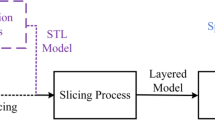Abstract
Fused deposition modeling (FDM), one of the earliest and typical additive manufacturing (AM) technologies, holds great potential in a wide range of industrial applications due to their increasing availability, simplicity, affordability, and capability to fabricate both prototypes and functional parts without limitation on geometric complexity. Notwithstanding many evident advantages over traditional subtractive manufacturing methods, there are still some limitations of this rapidly developing technique. One intractable problem is the undesirable surface finish from the layer-by-layer manufacturing process, where the stair-step issue appears unavoidably. This problematic phenomenon becomes much more serious when fabricating the surface with some minute but critical features. In order to solve these problems, curved layer manufacturing method is a good substitute for general flat fused deposition modeling. This work is an exploratory study for curved layer fused deposition (CLFD), involving the modeling and process planning, which are the foundation for the implementation of CLFD. The physical model for CLFD is developed firstly, and subsequently, the process planning, including the slicing procedure and the extruder path generation, is analyzed and presented. The output from the process planning could be applied in the fabrication of curved surfaces, which would possess tiny features and exhibit excellent smoothness instead of annoying exterior appearance. At last, the implementation of the proposed strategies and approaches on a bowl-like surface is provided to verify the effectiveness and advantages of CLFD.
Similar content being viewed by others
References
Wong KV, Hernandez A (2012) A review of additive manufacturing. ISRN Mech Eng 2012:1–10. doi:10.5402/2012/208760
Steuben JC, Iliopoulos AP, Michopoulos JG (2016) Implicit slicing for functionally tailored additive manufacturing. Comput Des 77:107–119. doi:10.1016/j.cad.2016.04.003
Pandey PM, Reddy NV, Dhande SG (2003) Improvement of surface finish by staircase machining in fused deposition modeling. J Mater Process Technol 132:323–331
Wang J, Xie H, Weng Z et al (2016) A novel approach to improve mechanical properties of parts fabricated by fused deposition modeling. Mater Des 105:152–159. doi:10.1016/j.matdes.2016.05.078
Boschetto A, Bottini L (2016) Design for manufacturing of surfaces to improve accuracy in fused deposition modeling. Robot Comput Integr Manuf 37:103–114. doi:10.1016/j.rcim.2015.07.005
Liu X, Shapiro V (2016) Homogenization of material properties in additively manufactured structures. Comput Des 78:71–82. doi:10.1016/j.cad.2016.05.017
Boschetto A, Bottini L (2014) Accuracy prediction in fused deposition modeling. Int J Adv Manuf Technol 73:913–928. doi:10.1007/s00170-014-5886-4
Ahn D, Kweon JH, Kwon S et al (2009) Representation of surface roughness in fused deposition modeling. J Mater Process Technol 209:5593–5600. doi:10.1016/j.jmatprotec.2009.05.016
Boschetto A, Giordano V, Veniali F (2012) Modelling micro geometrical profiles in fused deposition process. Int J Adv Manuf Technol 61:945–956. doi:10.1007/s00170-011-3744-1
Jin Y, Li H, He Y, Fu J (2015) Quantitative analysis of surface profile in fused deposition modeling. Addit Manuf 8:142–148. doi:10.1016/j.addma.2015.10.001
Boschetto A, Bottini L, Veniali F (2016) Finishing of fused deposition modeling parts by CNC machining. Robot Comput Integr Manuf 41:92–101. doi:10.1016/j.rcim.2016.03.004
Rahmati S, Vahabli E (2015) Evaluation of analytical modeling for improvement of surface roughness of FDM test part using measurement results. Int J Adv Manuf Technol 79:823–829. doi:10.1007/s00170-015-6879-7
Sood AK, Ohdar RK, Mahapatra SS (2009) Improving dimensional accuracy of fused deposition modelling processed part using grey Taguchi method. Mater Des 30:4243–4252. doi:10.1016/j.matdes.2009.04.030
Bansal R (2011) Improving dimensional accuracy of fused deposition modelling (FDM) parts using response surface methodology.
Pennington RC, Hoekstra NL, Newcomer JL (2005) Significant factors in the dimensional accuracy of fused deposition modelling. Proc Inst Mech Eng Part E J Process Mech Eng 219:89–92. doi:10.1243/095440805x6964
McCullough EJ, Yadavalli VK (2013) Surface modification of fused deposition modeling ABS to enable rapid prototyping of biomedical microdevices. J Mater Process Technol 213:947–954. doi:10.1016/j.jmatprotec.2012.12.015
Galantucci LM, Lavecchia F, Percoco G (2010) Quantitative analysis of a chemical treatment to reduce roughness of parts fabricated using fused deposition modeling. CIRP Ann - Manuf Technol 59:247–250
Chakraborty D, Aneesh Reddy B, Roy Choudhury A (2008) Extruder path generation for curved layer fused deposition modeling. CAD Comput Aided Des 40:235–243. doi:10.1016/j.cad.2007.10.014
Patel Y, Kshattriya A, Singamneni SB, Roy Choudhury A (2015) Application of curved layer manufacturing for preservation of randomly located minute critical surface features in rapid prototyping. Rapid Prototyp J 21:725–734. doi:10.1108/RPJ-07-2013-0073
Singamneni S, Diegel O, Huang B (2010) Curved layer fused deposition modeling. Aut Univ
Huang B, Singamneni S, Diegel O (2008) Construction of a curved layer rapid prototyping system: integrating mechanical, electronic and software engineering. Int. Conf. Mechatronics Mach. Vis. Pract, In, pp. 599–603
Singamneni S, Roychoudhury A, Diegel O, Huang B (2012) Modeling and evaluation of curved layer fused deposition. J Mater Process Technol 212:27–35
Huang B, Singamneni S (2012) Alternate slicing and deposition strategies for fused deposition modelling of light curved parts. J Achiev Mater Manuf Eng 55
Huang B, Singamneni SB (2015) Curved layer adaptive slicing (CLAS) for fused deposition modelling. Rapid Prototyp J 21:354–367
Huang B, Singamneni S (2013) Curved layer fused deposition modeling with varying raster orientations. Appl Mech Mater 446-447:263–269
Huang B, Singamneni S (2014) A mixed-layer approach combining both flat and curved layer slicing for fused deposition modelling. Proc Inst Mech Eng Part B J Eng Manuf:229
Allen RJA, Trask RS (2015) An experimental demonstration of effective curved layer fused filament fabrication utilising a parallel deposition robot. Addit Manuf 8:78–87
Turner BN, Strong R, SA G (2014) A review of melt extrusion additive manufacturing processes: I. Process design and modeling. Rapid Prototyp J 20:192–204. doi:10.1108/RPJ-01-2013-0012
Piegl L, Tiller W (1987) Curve and surface constructions using rational B-splines. Comput Des 19:485–498
Feng HY, Li H (2002) Constant scallop-height tool path generation for three-axis sculptured surface machining. Comput Des 34:647–654
Author information
Authors and Affiliations
Corresponding author
Rights and permissions
About this article
Cite this article
Jin, Y., Du, J., He, Y. et al. Modeling and process planning for curved layer fused deposition. Int J Adv Manuf Technol 91, 273–285 (2017). https://doi.org/10.1007/s00170-016-9743-5
Received:
Accepted:
Published:
Issue Date:
DOI: https://doi.org/10.1007/s00170-016-9743-5




